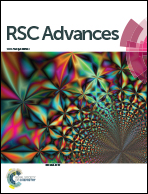Calculation of protein–ligand binding affinities based on a fragment quantum mechanical method†
Abstract
An electrostatically embedded generalized molecular fractionation with conjugate caps (EE-GMFCC) method (J. Phys. Chem. A, 2013, 117, 7149) has been successfully used for efficient linear-scaling quantum mechanical (QM) calculations of protein energies. Furthermore, an efficient approach that combined the EE-GMFCC method with a conductor-like polarizable continuum model (CPCM), termed as EE-GMFCC-CPCM (J. Chem. Phys., 2013, 139, 214104), was developed for ab initio calculations of the electrostatic solvation energy of proteins. In this study, we applied the EE-GMFCC-CPCM method for the calculation of binding affinities of 14 avidin–biotin analogues. The calculation delineated the contributions of interaction energy and electrostatic solvation energy to the binding affinity. The binding affinity of each ligand bound to avidin was calculated at the HF/6-31G* and B3LYP/6-31G* levels with empirical dispersion corrections, respectively. The correlation coefficient (R) between the calculated binding energies and experimental values is 0.75 at the HF/6-31G*-D level based on single complex structure calculations, as compared to 0.73 of the force field result. On the other hand, the correlation coefficient between the calculated binding energies and the experimental values is 0.85 at the B3LYP/6-31G*-D level based on single complex structure calculations, and this correlation can be further improved to 0.88 when multiple snapshots are considered. Our study demonstrates that the EE-GMFCC-CPCM method is capable of providing reliable predictions of binding affinities for various ligands bound to the same target.


 Please wait while we load your content...
Please wait while we load your content...